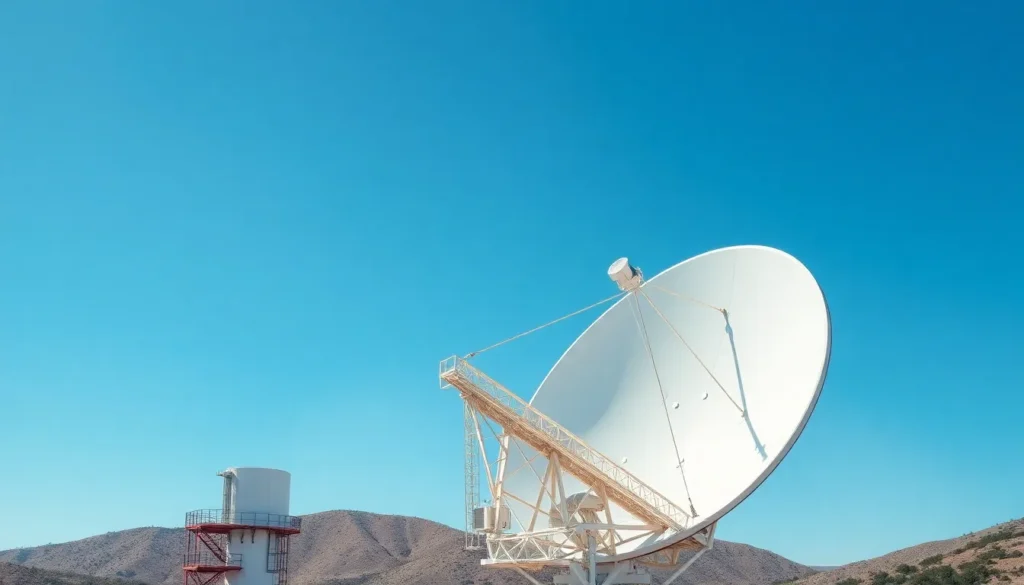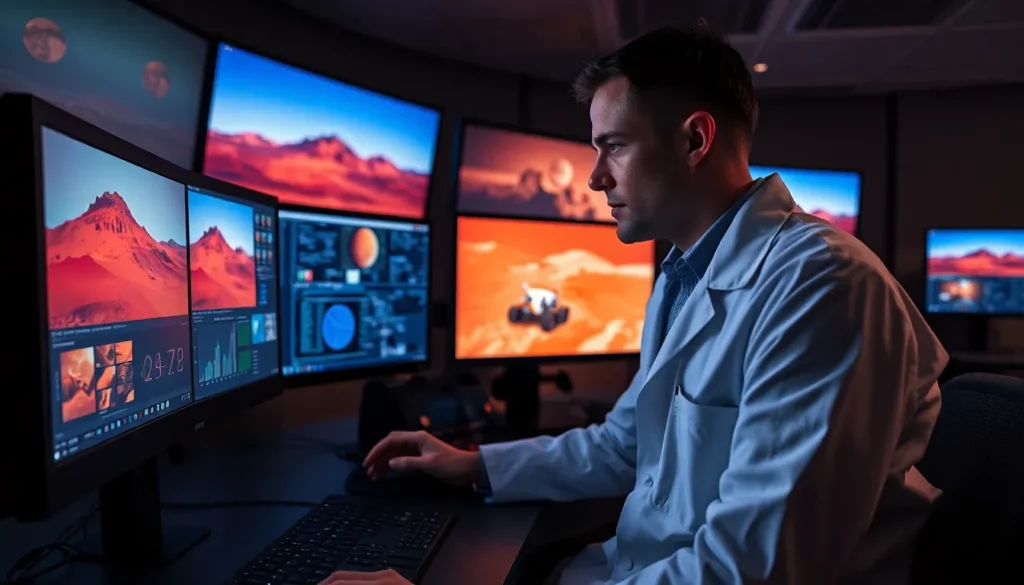Table of Contents
ToggleThe universe is the ultimate frontier, a vast playground of stars, planets, and mysteries waiting to be unraveled. While Earth has its fair share of wonders—like pizza and cat videos—nothing quite compares to the thrill of exploring the cosmos. Imagine floating among the stars, dodging asteroids, and discovering new worlds where aliens might just be better at karaoke than humans.
Overview of Universe Exploration
Universe exploration encompasses the study of celestial bodies, including stars, planets, and galaxies. Various agencies, like NASA and ESA, lead missions to uncover the secrets of the cosmos. Instruments like telescopes and rovers collect data that advances scientific knowledge.
Robotic missions often precede crewed exploration, allowing scientists to understand environments before human arrival. Unmanned spacecraft have explored Mars, revealing signs of ancient water and the potential for past life. These missions create a foundation for future human exploration.
Human missions, such as those planned for Mars, aim to establish a long-term presence beyond Earth. Astronauts conducting research in low Earth orbit contribute to advancements in technology and our understanding of space’s effects on the human body. Their work provides insights that prepare future explorers for deeper space travel.
Commercial spaceflight companies are emerging, making space more accessible. These enterprises are developing reusable rockets and other technologies to lower the cost of space travel. Increased participation from the private sector encourages innovation and accelerates exploration efforts.
The search for extraterrestrial life remains a primary goal. Telescopes on Earth and in orbit focus on identifying exoplanets in habitable zones around distant stars. Scientists analyze atmospheric compositions and detect potential biosignatures that hint at life beyond Earth.
New discoveries continue to reshape our understanding of the universe. Advancements in technology, such as AI and machine learning, enhance data analysis, uncovering patterns and providing deeper insights. As exploration progresses, humanity’s connection to the cosmos strengthens, opening paths to knowledge and discovery.
Historical Milestones in Universe Exploration

Historical advancements in universe exploration reveal humanity’s curiosity and ambition. Each milestone has contributed significantly to understanding our cosmos.
Early Observations and Theories
Ancient civilizations laid foundational theories about the universe. Astronomers like Ptolemy and Copernicus coined ideas on planetary motion, advancing the heliocentric model. Galileo Galilei’s telescopic discoveries in the early 17th century offered profound insights into celestial bodies. His observations included Jupiter’s moons and Saturn’s rings, challenging existing beliefs. Newton’s laws of motion and universal gravitation established a framework for future explorations.
Key Space Missions
Key space missions have marked pivotal moments in exploration. The launch of Sputnik 1 in 1957 initiated the space age, showcasing the capabilities of satellite technology. Following that, NASA’s Apollo program successfully landed astronauts on the Moon in 1969, achieving a monumental human exploration feat. The Voyager missions, launched in 1977, provided invaluable data about outer planets and continue to send signals from interstellar space. Mars rovers, such as Spirit and Curiosity, have greatly enhanced knowledge of Mars’ surface and atmosphere. Each mission has pushed the boundaries of what humanity knows about the universe, paving the way for future endeavors.
Modern Techniques in Universe Exploration
Modern techniques in universe exploration enhance humanity’s understanding of the cosmos. Advances in technology enable more detailed observations and data collection than ever before.
Telescopy and Imaging Technology
Telescopes use advanced optics for precise observation of distant celestial bodies. High-resolution imaging captures intricate details of galaxies and nebulae. Instruments like the Hubble Space Telescope and the upcoming James Webb Space Telescope provide critical data on cosmic phenomena. These technologies analyze light from stars and exoplanets, revealing their compositions and distances. Insights into atmospheric conditions of remote planets emerge from spectroscopic techniques. Observations made through these telescopes expand knowledge of the universe’s structure and evolution.
Space Probes and Rovers
Space probes and rovers explore planets and moons in situ, providing valuable data. Notable probes such as Voyager 1 and Voyager 2 continue their journey, delivering information about interstellar space. Rovers like Curiosity and Perseverance analyze Martian soil and climate, collecting samples crucial for understanding potential life. Instruments onboard these machines assess environmental conditions and geological features. Autonomous navigation capabilities enable rovers to traverse challenging terrains without direct human control. Data gathered from these missions significantly enhance scientific knowledge of our solar system.
The Role of International Collaboration
International collaboration plays a vital role in universe exploration. Diverse nations contribute expertise, resources, and technologies to tackle complex challenges in space.
Major Space Agencies Involved
NASA, ESA, Roscosmos, and CNSA lead global efforts in space exploration. NASA conducts crewed and robotic missions, focusing on deep space and Mars. ESA collaborates with multiple countries, emphasizing Earth observation and technology development. Roscosmos pursues human spaceflight and launches payloads to the International Space Station (ISS). CNSA, China’s national space agency, aims for lunar exploration and Mars missions. Each agency’s unique strengths enhance scientific discovery and innovation.
Joint Missions and Achievements
Collaborative missions yield significant advancements in space science. The ISS showcases how nations unite to conduct experiments and research in zero gravity. Additionally, missions like Mars 2020 exemplify successful partnerships, leveraging shared data and technology. Roscosmos and ESA’s ExoMars program focuses on searching for signs of life on the Red Planet, while the upcoming Lunar Gateway will support lunar exploration with international cooperation. These joint efforts drive humanity’s quest to understand the universe.
The Future of Universe Exploration
Advancements in technology and ambition drive the future of universe exploration.
Upcoming Missions and Goals
NASA’s Artemis program aims for a sustainable lunar presence by 2024. ESA’s JUICE mission will explore Jupiter’s icy moons, targeting a launch in 2023. Missions to Mars, such as those planned by SpaceX, focus on colonization and resource utilization. Telescopes like the James Webb Space Telescope will analyze exoplanets, searching for evidence of life. Collaboration between agencies will facilitate more ambitious missions.
Prospects for Human Exploration
Human exploration of Mars aims for crewed missions by the late 2020s. Astronauts will conduct research on Martian soil, exploring past water sources. Establishing a base on the Moon serves as a critical step for longer missions. Long-term health studies will help understand how space environments affect humans. Developing life-support systems will enhance crew sustainability during extended missions.
The journey of universe exploration is just beginning. As humanity reaches for the stars the excitement of discovery fuels innovation and collaboration. Each mission uncovers new knowledge about our cosmos and our place within it.
With advancements in technology and the rise of commercial spaceflight the possibilities are expanding. The quest for extraterrestrial life and the establishment of a sustainable presence on other celestial bodies highlight the ambition driving this exploration.
As nations unite to tackle the complexities of space science the future holds immense potential. The next chapters in this cosmic adventure promise to deepen understanding and inspire generations to come.






